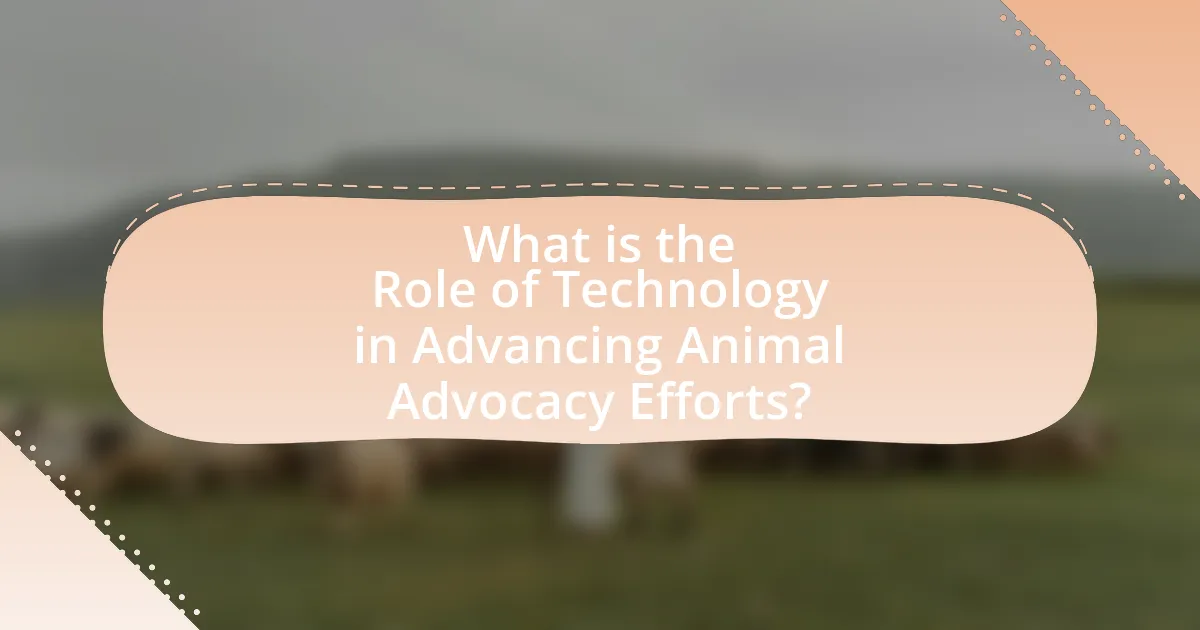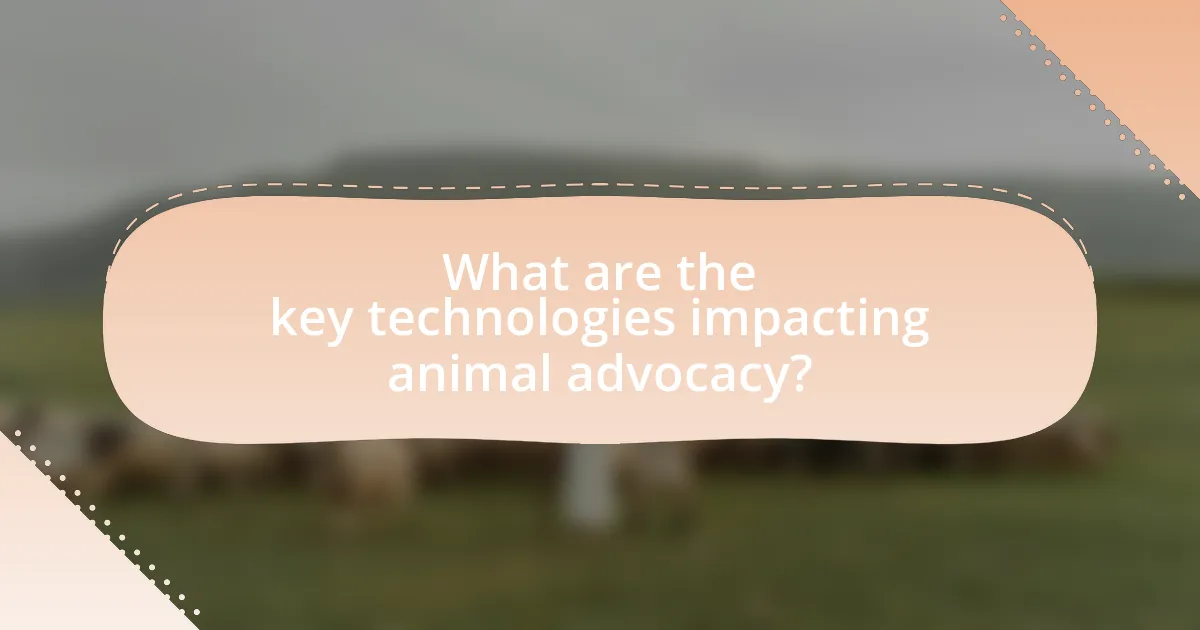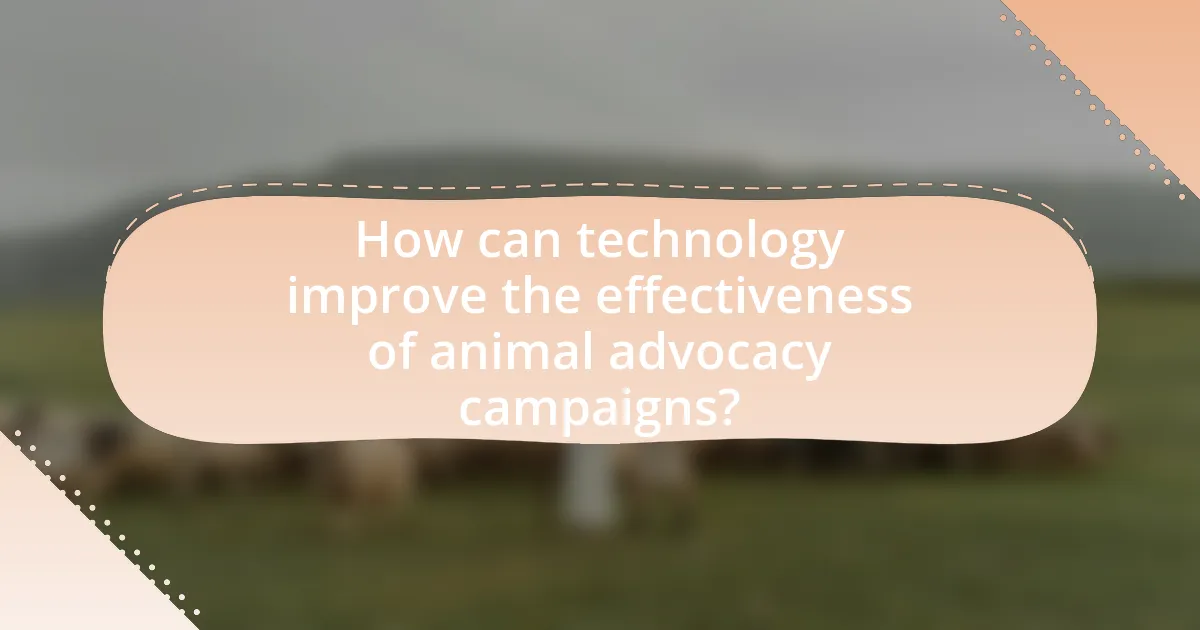The article examines the significant role of technology in advancing animal advocacy efforts, highlighting its impact on communication, awareness, and fundraising. It discusses how digital platforms, including social media and mobile applications, enhance outreach and engagement, enabling organizations to mobilize support for animal rights issues effectively. The article also explores specific technologies utilized in advocacy, such as data analytics and virtual reality, and addresses the challenges faced by animal advocacy that technology can help overcome. Additionally, it emphasizes best practices for integrating technology into campaigns while considering ethical implications and potential risks associated with its use.

What is the Role of Technology in Advancing Animal Advocacy Efforts?
Technology plays a crucial role in advancing animal advocacy efforts by enhancing communication, increasing awareness, and facilitating fundraising. Digital platforms enable organizations to reach a broader audience, allowing for the rapid dissemination of information regarding animal rights issues. For instance, social media campaigns have successfully mobilized public support for various causes, evidenced by the viral spread of hashtags like #SaveTheWhales, which raised awareness and prompted legislative action. Additionally, technology aids in data collection and analysis, enabling advocates to present compelling evidence for policy changes, such as studies showing the impact of factory farming on animal welfare. Furthermore, online fundraising tools have significantly increased financial support for animal shelters and rescue organizations, with platforms like GoFundMe raising millions for specific animal welfare projects. Overall, technology serves as a powerful ally in the fight for animal rights, driving engagement and support through innovative means.
How has technology transformed animal advocacy practices?
Technology has significantly transformed animal advocacy practices by enhancing communication, outreach, and fundraising capabilities. Digital platforms enable organizations to reach broader audiences through social media campaigns, online petitions, and virtual events, increasing awareness and engagement. For instance, the use of social media has led to viral campaigns, such as the Ice Bucket Challenge, which raised millions for animal welfare causes. Additionally, technology facilitates data collection and analysis, allowing advocates to track animal welfare trends and measure the impact of their efforts more effectively. The integration of mobile apps for reporting animal cruelty has also empowered individuals to take action quickly, further strengthening advocacy initiatives.
What specific technologies are being utilized in animal advocacy?
Specific technologies utilized in animal advocacy include social media platforms, mobile applications, data analytics, and virtual reality. Social media platforms enable organizations to raise awareness and mobilize support for animal rights campaigns, reaching millions of users quickly. Mobile applications facilitate direct engagement with supporters, allowing for actions such as signing petitions or donating to causes. Data analytics helps organizations track trends and measure the impact of their advocacy efforts, ensuring more effective strategies. Virtual reality is used to create immersive experiences that educate the public about animal welfare issues, fostering empathy and understanding. These technologies collectively enhance the effectiveness of animal advocacy initiatives.
How do these technologies enhance communication and outreach?
Technologies enhance communication and outreach by enabling real-time interaction and broad dissemination of information. For instance, social media platforms allow animal advocacy organizations to reach millions of users instantly, facilitating awareness campaigns and mobilizing support for various causes. According to a study by the Pew Research Center, 69% of adults in the U.S. use social media, which provides a vast audience for advocacy messages. Additionally, tools like email marketing and online petitions streamline the process of engaging supporters, making it easier to organize events and gather donations. These technologies not only increase visibility but also foster community engagement, as evidenced by the rise in online fundraising efforts that have significantly boosted financial support for animal welfare initiatives.
Why is technology essential for modern animal advocacy?
Technology is essential for modern animal advocacy because it enhances communication, mobilizes support, and increases awareness about animal rights issues. Digital platforms enable organizations to reach a global audience, facilitating campaigns that can quickly gather signatures for petitions or mobilize protests. For instance, social media campaigns have successfully raised awareness about specific animal welfare issues, leading to significant legislative changes, such as the banning of certain animal testing practices in multiple countries. Furthermore, technology allows for data collection and analysis, which helps advocates to present compelling evidence to support their causes, thereby influencing public opinion and policy decisions effectively.
What challenges does animal advocacy face that technology can address?
Animal advocacy faces challenges such as limited public awareness, inefficient communication, and resource constraints, which technology can effectively address. For instance, social media platforms enhance outreach by allowing advocates to share information rapidly, reaching millions and raising awareness about animal rights issues. Additionally, data analytics can identify trends in public sentiment, enabling targeted campaigns that resonate with specific audiences. Furthermore, crowdfunding platforms facilitate financial support for animal welfare initiatives, overcoming resource limitations. These technological solutions have proven effective in mobilizing support and increasing the impact of animal advocacy efforts.
How does technology improve data collection and analysis in advocacy?
Technology enhances data collection and analysis in advocacy by enabling real-time data gathering, improving accuracy, and facilitating comprehensive analysis. For instance, digital tools such as online surveys and social media analytics allow advocates to collect large volumes of data quickly and efficiently, capturing public sentiment and engagement levels. Additionally, data visualization software helps in interpreting complex datasets, making it easier for advocates to identify trends and patterns that inform their strategies. According to a 2021 study by the Pew Research Center, 79% of advocacy organizations reported that technology significantly improved their ability to analyze data, leading to more informed decision-making and effective campaigns.

What are the key technologies impacting animal advocacy?
Key technologies impacting animal advocacy include social media, data analytics, and artificial intelligence. Social media platforms enable organizations to raise awareness, mobilize supporters, and share information rapidly, significantly increasing outreach and engagement. Data analytics allows advocates to track trends, measure the impact of campaigns, and identify areas needing attention, enhancing strategic decision-making. Artificial intelligence is utilized for monitoring animal welfare, analyzing large datasets for research, and automating tasks, which improves efficiency in advocacy efforts. These technologies collectively enhance the effectiveness and reach of animal advocacy initiatives.
How do social media platforms contribute to animal advocacy efforts?
Social media platforms significantly enhance animal advocacy efforts by providing a space for awareness, community building, and mobilization. These platforms enable organizations and individuals to share impactful stories, images, and videos that highlight animal welfare issues, reaching millions of users quickly. For instance, campaigns like #MeatlessMonday and #AdoptDontShop have gained traction on platforms like Instagram and Twitter, leading to increased public engagement and participation in animal rights initiatives. According to a study by the Pew Research Center, 69% of adults in the U.S. use social media, making it a powerful tool for advocacy groups to disseminate information and rally support for legislative changes related to animal protection.
What are the most effective strategies for using social media in advocacy?
The most effective strategies for using social media in advocacy include creating engaging content, leveraging storytelling, utilizing targeted advertising, and fostering community engagement. Engaging content, such as eye-catching visuals and informative posts, captures attention and encourages sharing, which amplifies the message. Storytelling humanizes the cause, making it relatable and emotionally impactful, as seen in campaigns that highlight individual animal stories. Targeted advertising allows advocates to reach specific demographics, increasing the likelihood of engagement and support. Fostering community engagement through interactive posts, polls, and discussions builds a loyal supporter base, as evidenced by successful advocacy campaigns that have mobilized large groups for action.
How can social media campaigns raise awareness and funds?
Social media campaigns can raise awareness and funds by leveraging their vast reach and engagement capabilities to connect with a large audience. These campaigns utilize targeted messaging, compelling visuals, and interactive content to inform the public about specific causes, such as animal advocacy, thereby increasing visibility and understanding of the issues at hand. For instance, platforms like Facebook and Instagram allow organizations to share stories, videos, and images that resonate emotionally with users, prompting them to take action.
Moreover, social media campaigns often incorporate fundraising tools, such as donation buttons and crowdfunding links, making it easy for supporters to contribute financially. According to a report by the Pew Research Center, 69% of adults in the U.S. use social media, providing a significant opportunity for campaigns to reach potential donors. Additionally, successful campaigns often employ hashtags and challenges that encourage sharing and participation, further amplifying their message and fundraising efforts.
What role do mobile applications play in animal advocacy?
Mobile applications serve as vital tools in animal advocacy by facilitating communication, education, and mobilization of supporters. These applications enable organizations to disseminate information about animal welfare issues, promote campaigns, and engage users through features like petitions and donation platforms. For instance, apps like “Petfinder” connect potential adopters with animals in need of homes, while “iAnimal” raises awareness about animal rights through educational content. The effectiveness of mobile applications in reaching a broad audience is evidenced by the increasing number of downloads and user engagement metrics, demonstrating their significant impact on advocacy efforts.
What features make mobile apps effective for advocacy?
Mobile apps are effective for advocacy due to features such as user engagement tools, real-time communication, and data collection capabilities. User engagement tools, like push notifications and social sharing options, facilitate immediate interaction and mobilization of supporters. Real-time communication features, including chat functions and live updates, allow advocates to disseminate information quickly and respond to events as they unfold. Data collection capabilities enable organizations to gather insights on user behavior and preferences, which can inform targeted advocacy strategies. These features collectively enhance the ability of advocacy groups to connect with their audience, mobilize support, and drive impactful campaigns.
How can apps facilitate community engagement and support?
Apps can facilitate community engagement and support by providing platforms for communication, resource sharing, and mobilization among community members. These applications enable users to connect with like-minded individuals, share information about animal advocacy efforts, and organize events or campaigns effectively. For instance, platforms like Facebook and Meetup allow users to create groups focused on animal welfare, fostering a sense of community and collaboration. Additionally, apps can offer features such as donation tools, volunteer sign-ups, and educational resources, which enhance participation and support for animal advocacy initiatives. Research indicates that mobile applications can increase community involvement by 30% by streamlining communication and making it easier for individuals to engage with causes they care about.

How can technology improve the effectiveness of animal advocacy campaigns?
Technology can improve the effectiveness of animal advocacy campaigns by enhancing communication, increasing outreach, and facilitating data collection. Digital platforms enable organizations to reach larger audiences through social media, email campaigns, and online petitions, significantly amplifying their message. For instance, the Humane Society of the United States utilized social media to mobilize over 1 million supporters for animal welfare legislation in 2020, demonstrating the power of technology in advocacy. Additionally, technology allows for the collection and analysis of data on animal populations and welfare issues, which can inform strategies and improve campaign targeting. The use of analytics tools can help organizations understand audience engagement and optimize their messaging, leading to more effective campaigns.
What are the best practices for integrating technology into advocacy campaigns?
The best practices for integrating technology into advocacy campaigns include utilizing social media platforms for outreach, employing data analytics for targeted messaging, and leveraging online petitions to mobilize support. Social media allows advocates to engage with a broader audience, as platforms like Facebook and Twitter have billions of users, facilitating real-time communication and community building. Data analytics enables organizations to identify key demographics and tailor their messages effectively, increasing the likelihood of engagement; for instance, studies show that targeted campaigns can improve response rates by up to 50%. Online petitions, such as those hosted on Change.org, have proven successful in gathering signatures and demonstrating public support, with some campaigns achieving millions of signatures, thereby influencing policy decisions.
How can data analytics enhance campaign strategies?
Data analytics can enhance campaign strategies by providing insights into audience behavior and preferences, allowing for targeted messaging and resource allocation. By analyzing data from social media interactions, website traffic, and past campaign performance, organizations can identify which strategies resonate most with their audience. For instance, a study by the Data & Marketing Association found that data-driven marketing can lead to a 20% increase in campaign effectiveness. This evidence demonstrates that leveraging data analytics not only improves engagement but also optimizes budget utilization, ultimately leading to more successful advocacy efforts.
What tools can help measure the impact of advocacy efforts?
Tools that can help measure the impact of advocacy efforts include social media analytics platforms, surveys, and impact assessment software. Social media analytics platforms, such as Hootsuite and Sprout Social, track engagement metrics like shares, likes, and comments, providing insights into audience reach and sentiment. Surveys can gather direct feedback from stakeholders and the public, quantifying changes in awareness or attitudes resulting from advocacy campaigns. Impact assessment software, like Logic Model or Social Impact Assessment tools, enables organizations to evaluate the effectiveness of their strategies by measuring specific outcomes against predefined goals. These tools collectively provide a comprehensive view of advocacy effectiveness, supported by data-driven insights.
What ethical considerations arise from using technology in animal advocacy?
The ethical considerations arising from using technology in animal advocacy include issues of consent, representation, and potential exploitation. Technology can facilitate the collection of data on animal welfare, but it raises questions about whether animals can give consent to be monitored or studied. Additionally, the portrayal of animals in digital campaigns may lead to misrepresentation, where the emotional appeal could overshadow factual accuracy. Furthermore, the use of technology can sometimes exploit animals for fundraising or awareness campaigns, prioritizing human interests over the well-being of the animals involved. These considerations highlight the need for ethical frameworks that prioritize animal rights and welfare in technological applications within advocacy efforts.
How can advocates ensure responsible use of technology?
Advocates can ensure responsible use of technology by implementing ethical guidelines and promoting transparency in their digital practices. Establishing clear standards for data privacy, consent, and the ethical treatment of animals in digital campaigns is essential. For instance, organizations like the Humane Society International emphasize the importance of using technology to enhance animal welfare while ensuring that all digital content respects animal rights and privacy. By adhering to these principles, advocates can foster trust and accountability in their technological initiatives.
What are the potential risks of technology in animal advocacy?
The potential risks of technology in animal advocacy include misinformation, privacy concerns, and over-reliance on digital platforms. Misinformation can spread rapidly through social media, leading to public confusion about animal welfare issues; for instance, false claims about animal treatment can undermine legitimate advocacy efforts. Privacy concerns arise when technology is used to track or monitor individuals involved in animal advocacy, potentially exposing them to harassment or legal repercussions. Additionally, over-reliance on digital platforms may result in a lack of direct engagement with communities, diminishing the effectiveness of advocacy campaigns. These risks highlight the need for careful consideration and management of technology’s role in animal advocacy.
What practical tips can enhance the use of technology in animal advocacy?
Utilizing social media platforms effectively can significantly enhance technology’s role in animal advocacy. By creating engaging content that raises awareness about animal welfare issues, organizations can reach a broader audience. For instance, the Humane Society of the United States has successfully used platforms like Instagram and Twitter to share impactful stories and mobilize supporters, resulting in increased donations and volunteer sign-ups. Additionally, employing data analytics tools allows advocates to track engagement metrics, helping to refine strategies for maximum impact. Research indicates that campaigns utilizing targeted social media advertising can increase visibility by up to 50%, demonstrating the effectiveness of these technological approaches in animal advocacy.